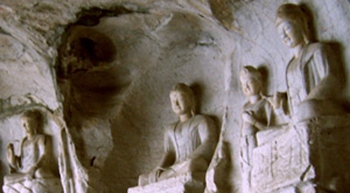Western Thousand-Buddha Cave
In Dunhuang, Gansu Province of China, we find the Dunhuang Mogao Grotto, which consists of the Mogao Caves, the Yulin Cave, and the Western Thousand-Buddha Cave.


The Western Thousand-Buddha Cave, which is situated to the west of Mogao Caves, is set into a cliff on the bank of the Dang River, 35 kilometers (about 22 miles) from Dunhuang City. Because the frescos in this cave are similar in structure and artistic style to those found in Mogao Caves, the Western Thousand-Buddha Cave is considered Dubhuang Buddhist art. Although the exact ages of the caves are not known, there is speculation that this Thousand-Buddha Cave may have emerged earlier than the Mogao Caves did.
There are 16 caverns, over 800 square meters (about 8,611 square feet) of murals and 34 painted clay statues. Some of the caverns were made in the Tang Dynasty (618 - 907) and others in the Wei Dynasty (386 - 534). Unfortunately, some of the caverns have collapsed, but ten of them are open to tourists.
In cavern No. 4, we find several very large statues. They are painted with strong bodies and slender eyebrows. In cavern No. 5, decorated during the Wei Dynasty, we find an inscription written by a Buddhist disciple called Tanzang for the figures of his dead grandparents and parents. So far, more than 70 characters can be seen clearly. Moving on to cavern No.7, we see one of the most famous aspects of the cave, a painting of Apsaras, a Buddhist god (known for dancing and singing), which is painted so vividly that it seems to come to life. In cavern No. 9, a unique structure shaped like nomad's yurt, serves as a valuable reference for researching the ethnic customs of Gansu Province. The god Nryana, an outstanding warrior in Buddhist legend, appears painted under some stone statues. In the caves, many colorful frescos tell informative Buddhist stories, putting these caves among the finest sources of Buddhist art in China.
Western Thousand-Buddha Cave is all this and more. The surrounding landscape is blessed with healthy ancient trees, and a nearby brook runs clear and clean, making this impressive repository of Buddhist art feel like Xanadu.













